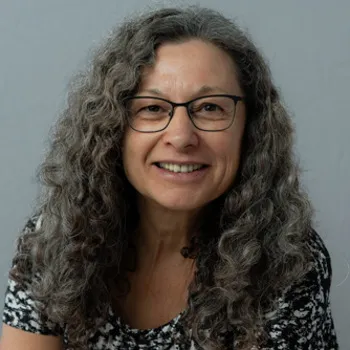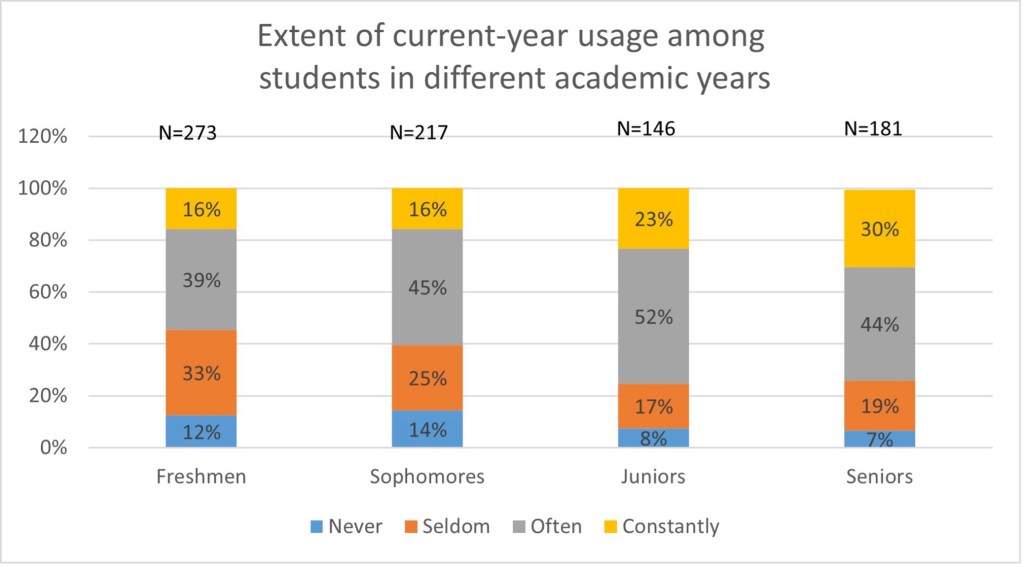The integration of generative artificial intelligence (GenAI) tools into higher education has sparked considerable discussion. An analysis of survey responses from 843 science and engineering undergraduate students across four academic years reveals several patterns of how students use GenAI tools throughout their academic journey.
In this post, we present and discuss these patterns.
Each year, during the fifth week of Technion’s winter semester, a survey is distributed to all undergraduates (about 10,000 students in total). The purpose of the survey is to let the students’ voices and perspectives be heard about their learning experience at the Technion, and to take relevant action according to the survey findings. This academic year (2024-2025), two new questions were added to the survey that address the use of GenAI tools by Technion students. The purpose of these additional questions was to discover the extent and ways in which students use GenAI tools spontaneously, and to derive insights about science and engineering learning and teaching using GenAI.
The first question that addressed the students’ use of GenAI tools was: “How often do you use or intend to use GenAI for educational purposes? GenAI refers to tools such as ChatGPT, Perplexity, Gemini, etc.” The students were asked to rank the extent of their usage on a four-point scale (Never, Seldom, Often, and Constantly) during three academic time periods: the previous school year (all but freshmen), the current year, and next year (all but seniors). The second question asked those students who use GenAI (all responders, except for those who checked the “never” option) to specify the educational purposes for which they use it.
An analysis of how students use GenAI indicates that as students progress through their academic journey, they tend to use GenAI for more and more purposes. While first-year students predominantly stick to a single use (81%), this narrow focus gradually broadens as they advance in their studies, with fourth-year students showing the most diverse application of GenAI tools. Only 55% of fourth-year students limited themselves to a single use, while 45% use GenAI for multiple purposes, including 2% who use GenAI across four different usages. This trend is particularly noticeable in the transition between the second and third years, when the percentage of students using GenAI for three or more purposes increases from 3% to 10%, and then increases significantly again in the fourth year, to 17%. This evolution suggests that, as students gain academic experience, they (a.) become more adept at identifying various opportunities to leverage AI tools effectively in their studies; and (b.) develop a more sophisticated understanding of GenAI’s potential applications, likely reflecting the increasingly complex requirements they face in upper-level coursework. In other words, as their academic challenges become more multifaceted, students appear to adapt by expanding their GenAI toolbox to meet these elevated demands.
Differences are evident also between the various cohorts in terms of frequency of use.
First, we looked at each cohort (year of study) and compared the students’ ranking of the extent of GenAI usage for both the previous and the current academic years and what they expect will happen next year. A consistent decline in the “never” and “seldom” categories was seen, alongside an increase in the “often” and “constantly” categories. This trend was mirrored across all academic years.
Second, we examined the students’ rankings across the four years of studies. During the current year (the time period all students were asked about), upper-level students (juniors and seniors) planned on using GenAI more “often” and “constantly” (freshmen at 55% and sophomores at 60% vs. juniors and seniors at 75%). Indeed, seniors exhibit the highest rate of constant usage in the current year, 30%, compared with 16% among first-year students (see Figure 1). This observation is validated by the analysis of the sophomores’ and juniors’ answers regarding the three time periods (see Figure 2).


For instance, among sophomores, the percentage of students who use AI tools “often” increased sharply from 28% in the previous year to 45% in the current year, with a projected increase to 52% next year. Among juniors, the percentage of non-users dropped from 14% in the previous year to 8% in the current year, with a further projected decrease to just 4% next year, while the percentage of constant users rose from 14% in the previous year to 23% in the current year, with a further projected increase to 28% next year. This shift, from occasional to regular use, suggests a broad acceptance of GenAI as an educational tool.
Third, the forward-looking data reflects an acceleration in the adoption of GenAI tools, as students progress in their academic journey. First-year students anticipated an increase in regular usage (“often” + “constantly”) from 55% to 62%, second-year students projected a jump from 61% to 70%, and third-year students expected an increase from 75% to an impressive record of 81% (see Figure 1 and Figure 3).

Conclusion
The evolution of GenAI tool usage by science and engineering students over their academic years provides valuable insights for both students, educators, and educational institutions in their attempt to understand how to effectively integrate these tools into the educational journey.
Our analysis reveals that GenAI tool usage in science and engineering higher education is not static, rather it evolves significantly. As students progress through their academic journey, they become more and more comfortable integrating GenAI tools into their learning process. Rather than simply replacing traditional learning methods, GenAI tools seem to adjust to the students’ changing needs, becoming more and more sophisticated as students develop their expertise.
For educators, this suggests that one-size-fits-all policies on GenAI usage might be less effective than year-specific guidelines that acknowledge students’ different needs and capabilities at each academic stage.
Educational institutions should consider these trends when developing policies and support systems. The data clearly show that GenAI tools are not just a passing trend but are becoming a fundamental part of how students learn and work.
Disclaimer: This blog was written with the help of Claude.ai and ChatGPT.

Yael Erez is a lecturer at the Technion’s Faculty of Computer Science and a faculty member at the Department of Electrical Engineering at the Braude College of Engineering in Karmiel, Israel. She is currently a doctoral student at the Technion’s Department of Education in Science and Technology, under the supervision of Orit Hazzan.

Orit Hazzan is a professor at the Technion’s Department of Education in Science and Technology. Her research focuses on computer science, software engineering, and data science education. For additional details, see https://orithazzan.net.technion.ac.il/.

